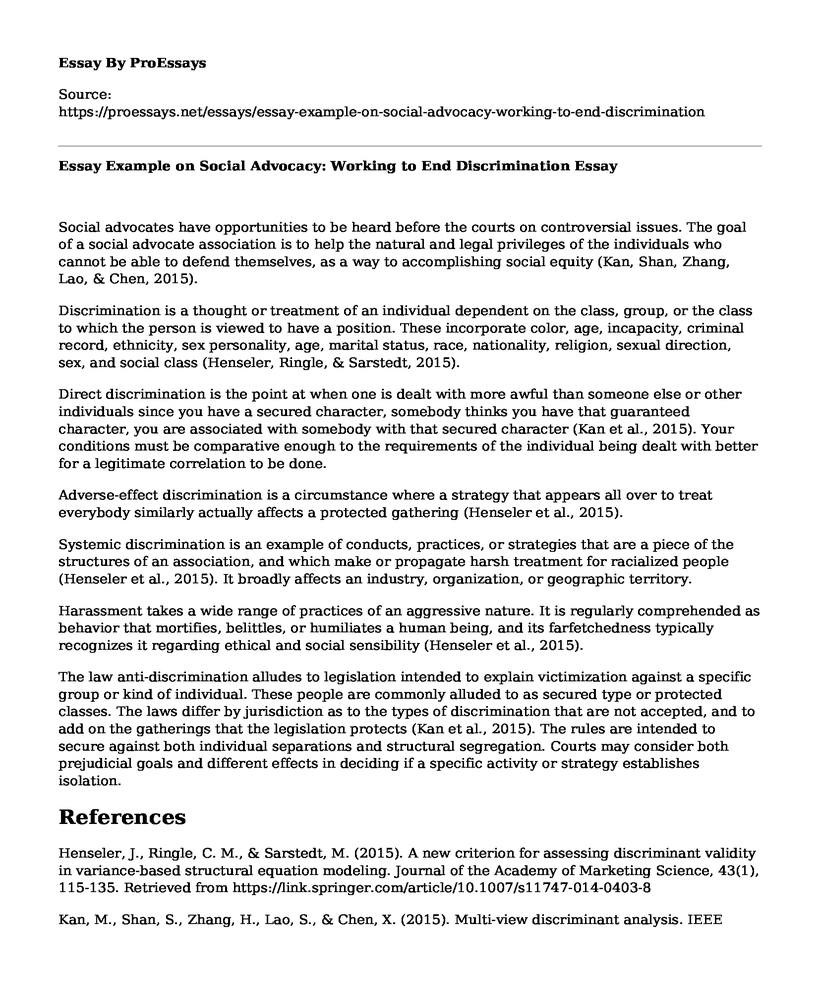Social advocates have opportunities to be heard before the courts on controversial issues. The goal of a social advocate association is to help the natural and legal privileges of the individuals who cannot be able to defend themselves, as a way to accomplishing social equity (Kan, Shan, Zhang, Lao, & Chen, 2015).
Discrimination is a thought or treatment of an individual dependent on the class, group, or the class to which the person is viewed to have a position. These incorporate color, age, incapacity, criminal record, ethnicity, sex personality, age, marital status, race, nationality, religion, sexual direction, sex, and social class (Henseler, Ringle, & Sarstedt, 2015).
Direct discrimination is the point at when one is dealt with more awful than someone else or other individuals since you have a secured character, somebody thinks you have that guaranteed character, you are associated with somebody with that secured character (Kan et al., 2015). Your conditions must be comparative enough to the requirements of the individual being dealt with better for a legitimate correlation to be done.
Adverse-effect discrimination is a circumstance where a strategy that appears all over to treat everybody similarly actually affects a protected gathering (Henseler et al., 2015).
Systemic discrimination is an example of conducts, practices, or strategies that are a piece of the structures of an association, and which make or propagate harsh treatment for racialized people (Henseler et al., 2015). It broadly affects an industry, organization, or geographic territory.
Harassment takes a wide range of practices of an aggressive nature. It is regularly comprehended as behavior that mortifies, belittles, or humiliates a human being, and its farfetchedness typically recognizes it regarding ethical and social sensibility (Henseler et al., 2015).
The law anti-discrimination alludes to legislation intended to explain victimization against a specific group or kind of individual. These people are commonly alluded to as secured type or protected classes. The laws differ by jurisdiction as to the types of discrimination that are not accepted, and to add on the gatherings that the legislation protects (Kan et al., 2015). The rules are intended to secure against both individual separations and structural segregation. Courts may consider both prejudicial goals and different effects in deciding if a specific activity or strategy establishes isolation.
References
Henseler, J., Ringle, C. M., & Sarstedt, M. (2015). A new criterion for assessing discriminant validity in variance-based structural equation modeling. Journal of the Academy of Marketing Science, 43(1), 115-135. Retrieved from https://link.springer.com/article/10.1007/s11747-014-0403-8
Kan, M., Shan, S., Zhang, H., Lao, S., & Chen, X. (2015). Multi-view discriminant analysis. IEEE transactions on pattern analysis and machine intelligence, 38(1), 188-194. Retrieved from https://ieeexplore.ieee.org/abstract/document/7110624
Cite this page
Essay Example on Social Advocacy: Working to End Discrimination. (2023, Feb 20). Retrieved from https://proessays.net/essays/essay-example-on-social-advocacy-working-to-end-discrimination
If you are the original author of this essay and no longer wish to have it published on the ProEssays website, please click below to request its removal:
- Essay Sample on Gibbs Reflection About the Job Interview
- Research Paper on Invertebrate Zoology
- Talent Management: Recruiting, Hiring, Training & Retaining Talent - Essay Sample
- Paper Example on Corporate Social Responsibility (CSR): Is It A Necessity?
- Immigration to US: A Haven for Migrants or an Unlawful Entrance? - Essay Sample
- Essay Example on Management Project Gave Me Real-World Experience & Knowledge
- Essay Example on Project Management: A Key Aspect of Modern Organizations







